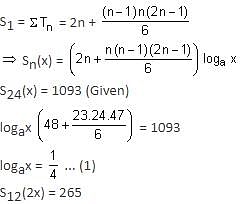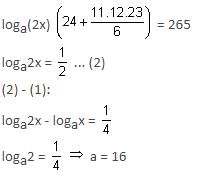JEE Exam > JEE Questions > Let Sn(x) = loga1/2 x +loga1/3 x +loga1/11 x ...
Start Learning for Free
Let Sn(x) = loga1/2 x + loga1/3 x + loga1/11 x loga18 x + loga1/27 x + .... up to n terms, where a > 1. If S24(x) = 1093 and S12(2x) = 265, then value of a is equal to _________.
Correct answer is '16'. Can you explain this answer?
Most Upvoted Answer
Let Sn(x) = loga1/2 x +loga1/3 x +loga1/11 x loga18 x +loga1/27 x + .....
To find Sn(x), we need to find the product of all the terms mentioned up to n terms.
We have:
Sn(x) = loga(1/2) * loga(1/3) * loga(1/11) * loga(18) * loga(1/27) * ...
Notice that the terms in the product alternate between positive and negative exponents. We can rearrange the terms to group the positive exponents together and the negative exponents together:
Sn(x) = (loga(1/2) * loga(18) * ...) * (loga(1/3) * loga(1/11) * loga(1/27) * ...)
The first group of terms can be simplified by using the property of logarithms:
loga(1/2) * loga(18) * ... = loga((1/2) * 18 * ...)
Similarly, the second group of terms can be simplified:
loga(1/3) * loga(1/11) * loga(1/27) * ... = loga((1/3) * (1/11) * (1/27) * ...)
Now, we can rewrite Sn(x) as:
Sn(x) = loga((1/2) * 18 * ...) * loga((1/3) * (1/11) * (1/27) * ...)
The terms inside each logarithm can be further simplified:
Sn(x) = loga((9) * ...) * loga((1/33) * ...)
Now, we can express Sn(x) as a single logarithm by multiplying the terms inside the logarithms:
Sn(x) = loga((9) * ...) * loga((1/33) * ...)
= loga((9) * (1/33) * ...)
= loga(9/33 * ...)
Therefore, Sn(x) = loga(9/33 * ...)
We have:
Sn(x) = loga(1/2) * loga(1/3) * loga(1/11) * loga(18) * loga(1/27) * ...
Notice that the terms in the product alternate between positive and negative exponents. We can rearrange the terms to group the positive exponents together and the negative exponents together:
Sn(x) = (loga(1/2) * loga(18) * ...) * (loga(1/3) * loga(1/11) * loga(1/27) * ...)
The first group of terms can be simplified by using the property of logarithms:
loga(1/2) * loga(18) * ... = loga((1/2) * 18 * ...)
Similarly, the second group of terms can be simplified:
loga(1/3) * loga(1/11) * loga(1/27) * ... = loga((1/3) * (1/11) * (1/27) * ...)
Now, we can rewrite Sn(x) as:
Sn(x) = loga((1/2) * 18 * ...) * loga((1/3) * (1/11) * (1/27) * ...)
The terms inside each logarithm can be further simplified:
Sn(x) = loga((9) * ...) * loga((1/33) * ...)
Now, we can express Sn(x) as a single logarithm by multiplying the terms inside the logarithms:
Sn(x) = loga((9) * ...) * loga((1/33) * ...)
= loga((9) * (1/33) * ...)
= loga(9/33 * ...)
Therefore, Sn(x) = loga(9/33 * ...)
Free Test
FREE
| Start Free Test |
Community Answer
Let Sn(x) = loga1/2 x +loga1/3 x +loga1/11 x loga18 x +loga1/27 x + .....

Sn(x) = (2 + 3 + 6 + 11 + 18 + 27 + ... + n terms) logax
Let S1 = 2 + 3 + 6 + 11 + 18 + 27 + ... + Tn
S1 = 2 + 3 + 6 + ... + Tn _____
Tn = 2 + 1 + 3 + 5 + ... + n terms
Tn = 2 + (n - 1)2



|
Explore Courses for JEE exam
|

|
Similar JEE Doubts
Let Sn(x) = loga1/2 x +loga1/3 x +loga1/11 x loga18 x +loga1/27 x + ....up to n terms, where a > 1. If S24(x) = 1093 and S12(2x) = 265, then value of a is equal to _________.Correct answer is '16'. Can you explain this answer?
Question Description
Let Sn(x) = loga1/2 x +loga1/3 x +loga1/11 x loga18 x +loga1/27 x + ....up to n terms, where a > 1. If S24(x) = 1093 and S12(2x) = 265, then value of a is equal to _________.Correct answer is '16'. Can you explain this answer? for JEE 2025 is part of JEE preparation. The Question and answers have been prepared according to the JEE exam syllabus. Information about Let Sn(x) = loga1/2 x +loga1/3 x +loga1/11 x loga18 x +loga1/27 x + ....up to n terms, where a > 1. If S24(x) = 1093 and S12(2x) = 265, then value of a is equal to _________.Correct answer is '16'. Can you explain this answer? covers all topics & solutions for JEE 2025 Exam. Find important definitions, questions, meanings, examples, exercises and tests below for Let Sn(x) = loga1/2 x +loga1/3 x +loga1/11 x loga18 x +loga1/27 x + ....up to n terms, where a > 1. If S24(x) = 1093 and S12(2x) = 265, then value of a is equal to _________.Correct answer is '16'. Can you explain this answer?.
Let Sn(x) = loga1/2 x +loga1/3 x +loga1/11 x loga18 x +loga1/27 x + ....up to n terms, where a > 1. If S24(x) = 1093 and S12(2x) = 265, then value of a is equal to _________.Correct answer is '16'. Can you explain this answer? for JEE 2025 is part of JEE preparation. The Question and answers have been prepared according to the JEE exam syllabus. Information about Let Sn(x) = loga1/2 x +loga1/3 x +loga1/11 x loga18 x +loga1/27 x + ....up to n terms, where a > 1. If S24(x) = 1093 and S12(2x) = 265, then value of a is equal to _________.Correct answer is '16'. Can you explain this answer? covers all topics & solutions for JEE 2025 Exam. Find important definitions, questions, meanings, examples, exercises and tests below for Let Sn(x) = loga1/2 x +loga1/3 x +loga1/11 x loga18 x +loga1/27 x + ....up to n terms, where a > 1. If S24(x) = 1093 and S12(2x) = 265, then value of a is equal to _________.Correct answer is '16'. Can you explain this answer?.
Solutions for Let Sn(x) = loga1/2 x +loga1/3 x +loga1/11 x loga18 x +loga1/27 x + ....up to n terms, where a > 1. If S24(x) = 1093 and S12(2x) = 265, then value of a is equal to _________.Correct answer is '16'. Can you explain this answer? in English & in Hindi are available as part of our courses for JEE.
Download more important topics, notes, lectures and mock test series for JEE Exam by signing up for free.
Here you can find the meaning of Let Sn(x) = loga1/2 x +loga1/3 x +loga1/11 x loga18 x +loga1/27 x + ....up to n terms, where a > 1. If S24(x) = 1093 and S12(2x) = 265, then value of a is equal to _________.Correct answer is '16'. Can you explain this answer? defined & explained in the simplest way possible. Besides giving the explanation of
Let Sn(x) = loga1/2 x +loga1/3 x +loga1/11 x loga18 x +loga1/27 x + ....up to n terms, where a > 1. If S24(x) = 1093 and S12(2x) = 265, then value of a is equal to _________.Correct answer is '16'. Can you explain this answer?, a detailed solution for Let Sn(x) = loga1/2 x +loga1/3 x +loga1/11 x loga18 x +loga1/27 x + ....up to n terms, where a > 1. If S24(x) = 1093 and S12(2x) = 265, then value of a is equal to _________.Correct answer is '16'. Can you explain this answer? has been provided alongside types of Let Sn(x) = loga1/2 x +loga1/3 x +loga1/11 x loga18 x +loga1/27 x + ....up to n terms, where a > 1. If S24(x) = 1093 and S12(2x) = 265, then value of a is equal to _________.Correct answer is '16'. Can you explain this answer? theory, EduRev gives you an
ample number of questions to practice Let Sn(x) = loga1/2 x +loga1/3 x +loga1/11 x loga18 x +loga1/27 x + ....up to n terms, where a > 1. If S24(x) = 1093 and S12(2x) = 265, then value of a is equal to _________.Correct answer is '16'. Can you explain this answer? tests, examples and also practice JEE tests.

|
Explore Courses for JEE exam
|

|
Signup for Free!
Signup to see your scores go up within 7 days! Learn & Practice with 1000+ FREE Notes, Videos & Tests.
























